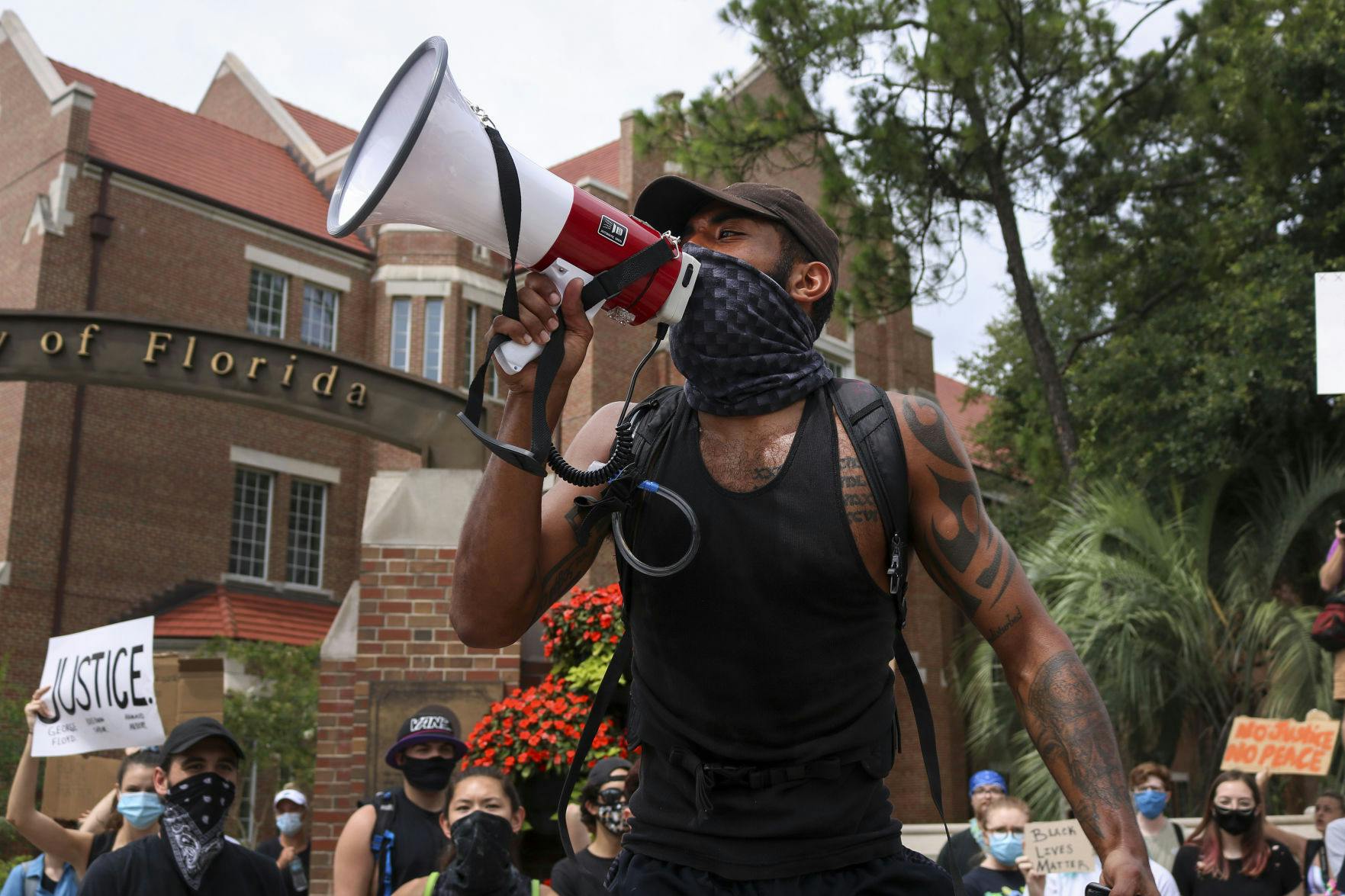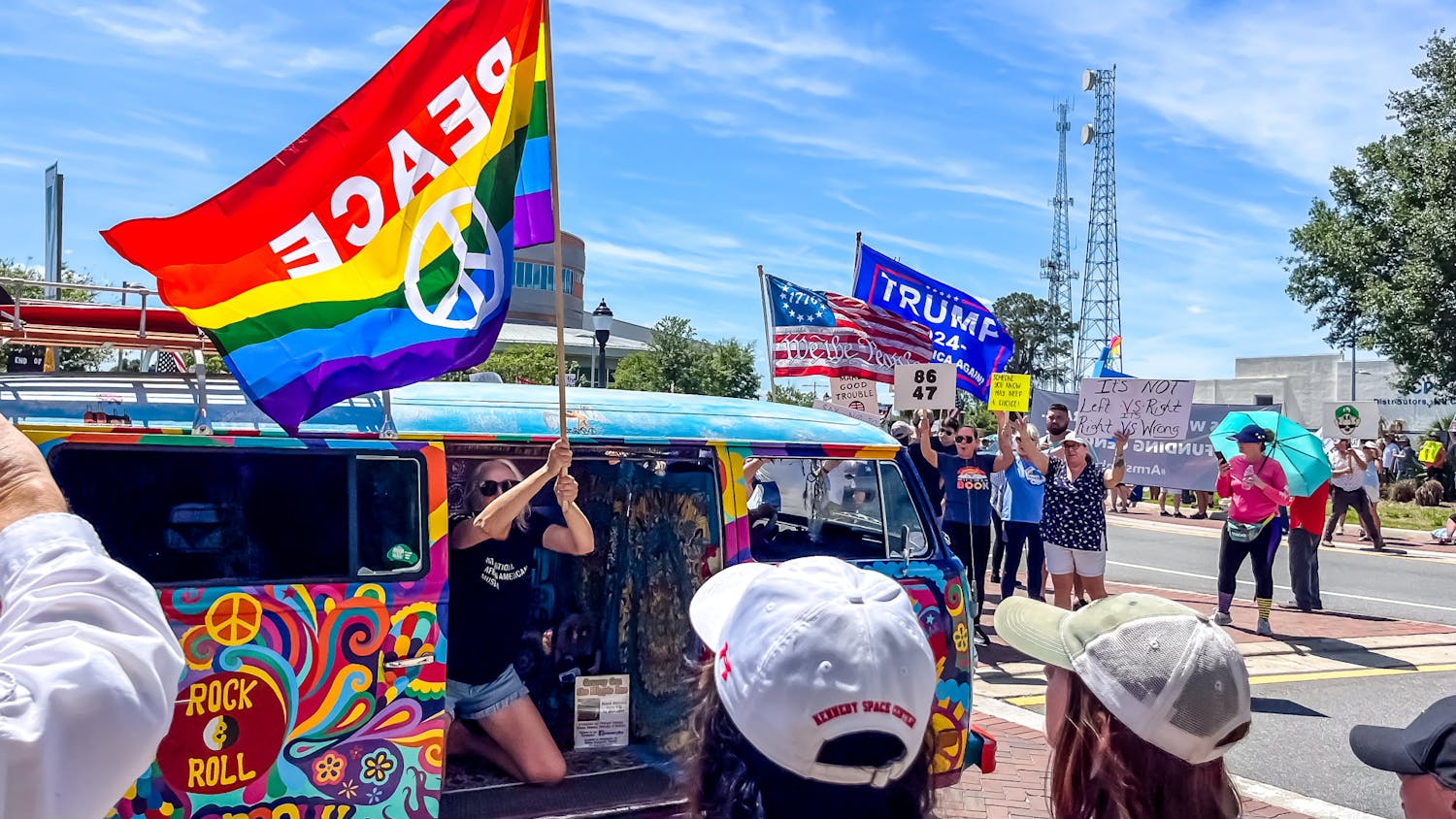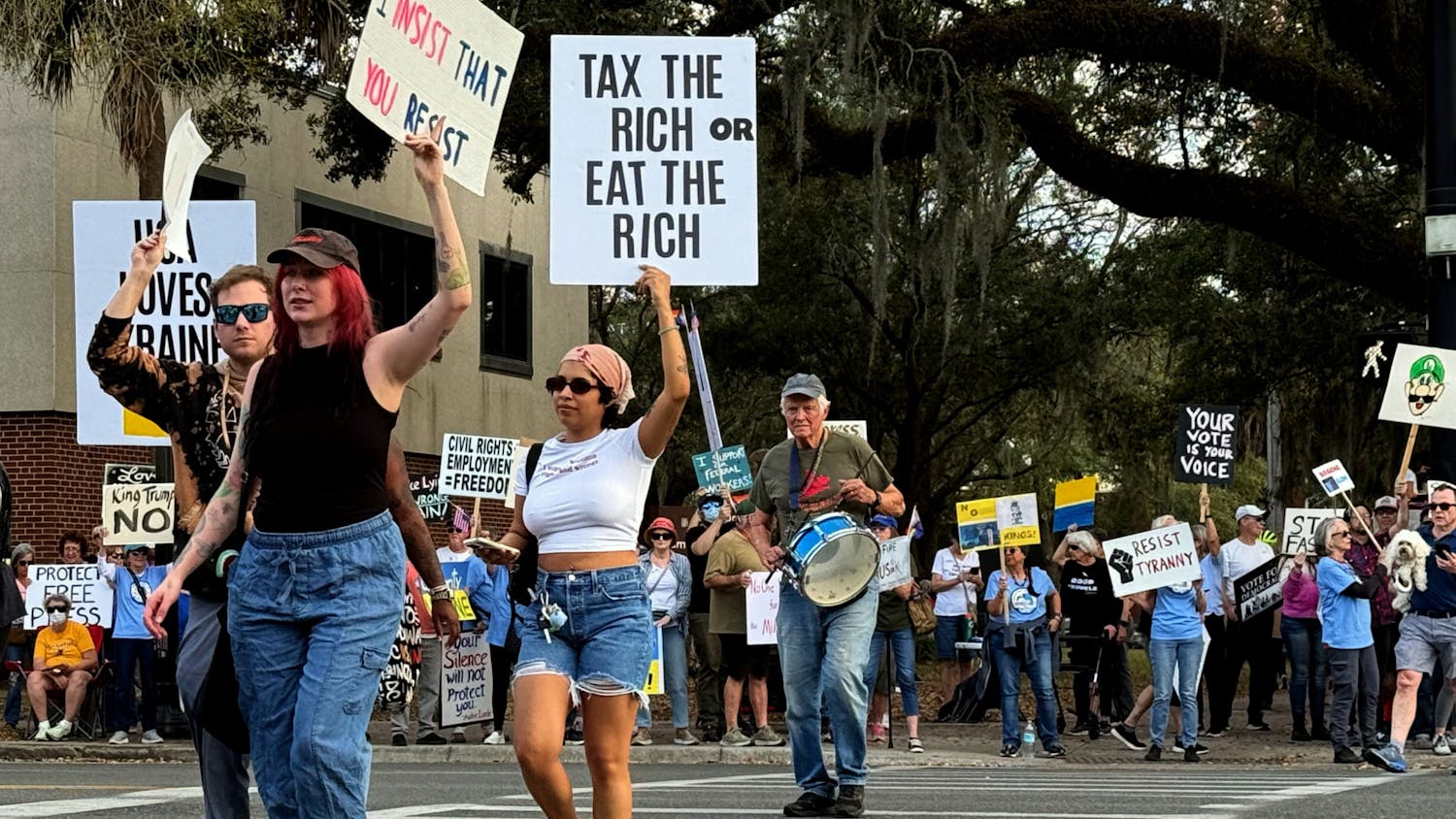
Daniel Brackett, a 24-year-old UF Physical Therapy Assistant and one of the organizers of the protest, shouts into a megaphone in front of a crowd of about 100 people at the intersection of 13th Street and University Avenue Wednesday as part of a protest against police brutality.
This Summer, I have helped cover several large Gainesville protests. This is an inside look at the steps I take to bring the news to you.
Discovering a protest
I usually become aware of protests through social media posts. Protests gain traction as they are shared by organizers, activist and advocacy groups and supporters. I became aware of Gainesville’s March for Our Freedom when an Alligator editor invited me to the event’s Facebook group, which currently has more than 6,000 members.
Once I know about these types of groups, I monitor them for other events, even after the original planned protest. Other activists often use these large groups to promote their own protests. I learned about the Seminary Lane protest after it was promoted in the March for Our Freedom Facebook group.
By staying up-to-date with these platforms, I can let my editors know about upcoming protests so they can assign them to reporters like me. Covering as many protests as we can allows our readers to learn about the movements sprouting in their community.
Preparing for a protest
When I took Reporting class with UF journalism professor Mike Foley, he hammered home that to be able to cover something properly, you have to know the basics before you step foot on the scene.
After I learn about an upcoming protest, I do preliminary reporting and conduct research on the topic. This allows me to ask protesters and any counter-protesters better informed questions than if I was going in blind.
I review previous articles published in The Alligator related to the topic and the groups organizing the protest. I also work with other reporters who are covering the event with me to reach out to organizers before the event to conduct a preliminary interview for background information.
Preliminary interviews allow us to have extended conversations with organizers. In-depth interviews aren't always possible during or after the protest because organizers coordinate the protest while it takes place and are unavailable.
In preparation for the March for Our Freedom protest, fellow Alligator reporter Natalia Galicza interviewed an event organizer. She was told how long the protest would last and the path the march would take, which allowed reporters to recognize spinoff protests. As the protest ended, several groups diverted onto different paths, and in our story, we were able to accurately reflect that they weren’t part of the official event.
Arriving at a protest
Before going to a protest, I make sure I have a mask, notepad, snacks, writing utensils and my phone, fully charged. I use my phone to record interviews with permission from the source, and I take notes on interviews I conduct and other details during the protest with the notebook.
I also wear my press pass, which has my name and picture on. The reason I wear it is so that I can disclose to protesters I am a reporter more easily. I also wear it so I can easily identify to law enforcement that I am a member of the press.
I arrive at protests early so I can take notes about the location before the crowd arrives. I write down any sensory details I think are important. Is the smell of candles heavy in the air? I write it down. Are sun rays shooting through overcast clouds? I write it down. Recording these things help me set the scene so I can help the reader know about details that would impact them if they were actually there.
It also allows me to interview protest organizers before they run the event. When I am interviewing someone during a protest, I can’t take notes on other things happening during the protest. Therefore, limiting the number of interviews I conduct during an event by speaking to people before or after helps me report on the event better.
During a protest
Protesters usually chant or make symbolic gestures like kneeling over the course of the event. I do not join them at any point of the protest, except for respecting moments of silence. I do this because it is my job to cover the news impartially and fairly, and I cannot do that if I am participating in the protest.
Instead, I jot down the words to every chant, prominent sign or speech that is given. It is my responsibility to include what protesters are saying so readers can hear their voices and know what is going on.
I also record details like the path the protesters take, because many times paths and destinations are just as important to the protests' message as words.
For my coverage of a BLM protest on June 13, I took notes on the path the protest followed and the length of each stop. The protest went through Pleasant Street, Gainesville’s first historically black neighborhood. Protest organizers stopped at several locations and talked about how the history of those stops played into the larger BLM movement.
I sent my notes to the Alligator’s Multimedia team. They created a graphic inspired by the path, which included points made to show readers where each stop was. The graphic included summaries of what protest organizers said at each stop.
During the same protest, fellow Alligator reporter Kaelyn Cassidy followed a family of three and included their perspective in the coverage.
During each protest, myself or another reporter working with me shadowed protesters who didn’t take part in organizing. This allows an on-the-ground perspective in the coverage. We always ask protesters for permission before shadowing them to respect their privacy.
I also look out for counter-protesters while covering a protest. Interviewing counter-protesters provides a different perspective that helps my articles cover as many parts of the issue as possible.
However, Alligator policy doesn’t permit anonymous sources, except in specific cases. While I may interview an anonymous source to gather background information, any information I collected will likely not be attributed to them in my story and I must confirm it through other sources. Additionally, if I interview someone who refuses to name themselves, I am not to include that information in the article.
I always attribute quotes and information from the sources at protests who gave them. This makes it clear that the information doesn’t reflect my opinion, but the subjects' own.
Including an anonymous source can blur this line, because no one is identified to be held accountable for what they say, and no check exists if I fail to represent what they say accurately. I only use anonymous sources if they are pivotal for reporting the news and if they need to be anonymous to protect their safety, as the Society of Professional Journalists’ Code of Ethics recommends.
When I covered a protest against the Israeli annexation of Palestine, I noticed counter-protesters on the other side of the street. I collected details from the scene, but all but one of the counter-protesters refused to provide quotes or comment.
The counter-protester who commented declined to provide his name. Because the source didn’t provide their name, I did not include their interview in the article.





